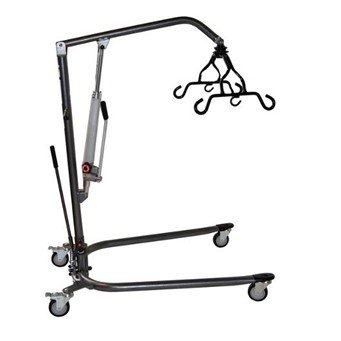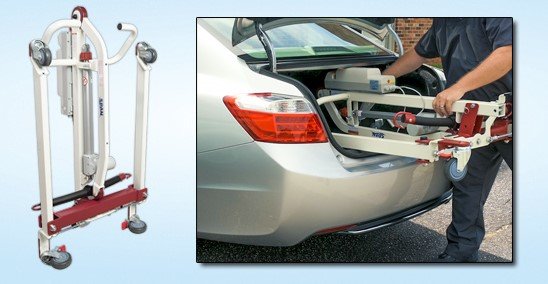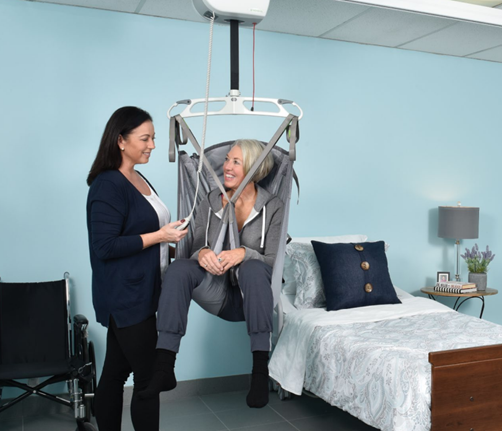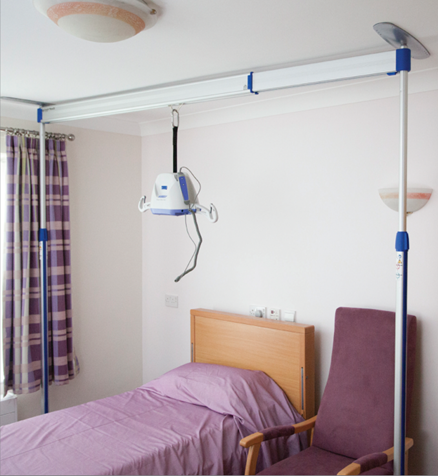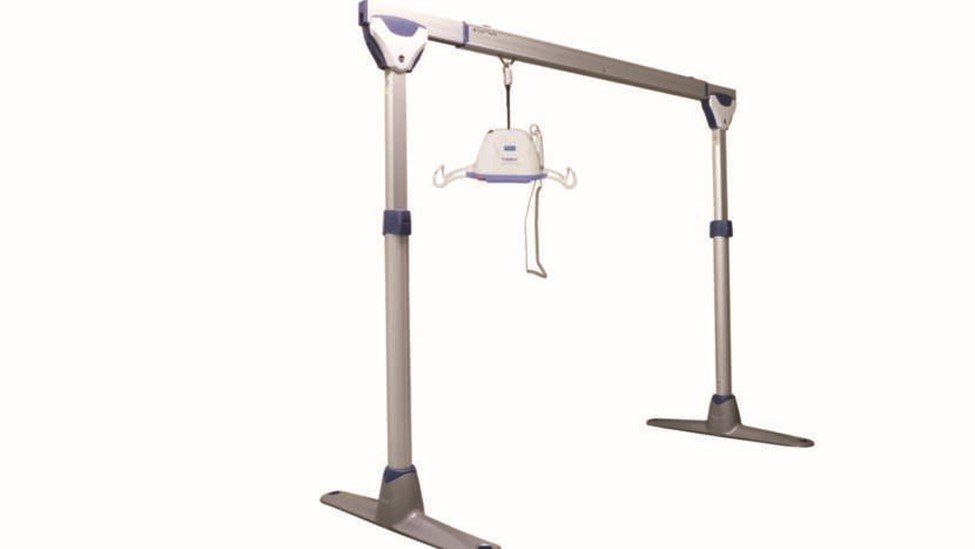What is a Hoyer Lift?
Hoyer lifts are excellent resources to help move a loved one from one surface to another, who would otherwise not be able to do so safely. Patients who use Hoyer lifts are generally considered bed-bound or wheelchair-bound. Hoyer lifts assist caregivers in helping their loved ones move from the bed, chair, wheelchair, or toilet without needing to physically lift them. The patient is placed in a sling that acts as a hammock, raising them up in a cradled position, and allows the caregiver to maneuver the patient over to their new surface. For more information on slings, please see our blog on “How to Choose a Hoyer Lift Sling.”
Hoyer lifts are a great fit for patients who:
Have significant weakness in their legs and are unable to stand safely
Have poor trunk control and require assistance to sit upright
Have cognitive impairments that prevent them from following safety instructions for transfers
Have weight bearing restrictions in their leg(s) following an injury, surgery or wound
If your loved one still has the strength to participate in standing and transfers, they may be a better fit for a sit-to-stand lift. See our blog posts on “What is the Difference between a Hoyer Lift and a Sit to Stand Lift?” and “What is the Difference between a Manual and Electric Patient Lift?” for more information.
For a video demo on how they work, check out our YouTube video here.
There are a few options available in the world of Hoyer lifts.
Floor Lifts:
Floor lifts are stand-alone units that can be moved around the home and are considered the “standard” model of Hoyer lifts. While there are many designs of floor lifts (compact, heavy-duty, travel), the lift mechanisms and operation are essentially the same. Floor lifts can be operated manually, or with power.
Manual Lifts: These are operated by a lever system, where the caregiver pulls back and forth on a lever to manually lift the patient. This does require some strength on the part of the caregiver, but the hydraulic system does help with the process. To lower the patient, the caregiver releases a lever to slowly lower them down.
Electric Power Lifts: These lifts function in the same manner as lever-operated lifts, but they use electricity for power, instead of a lever. The patient is lifted by means of a remote control, reducing the effort needed from both the patient and the caregiver. These lifts are easy to operate and offer a smooth ride for the patient without the stopping and starting felt by the manual lever. Powered lifts are heavier in nature, however, which can make them harder to steer and maneuver, especially on carpeted floors.
Specialty Lifts: There are specialized lifts that are designed for specific scenarios, which are not designed for typical every-day use. Some examples include:
Compact travel lifts: Lightweight and easy to disassemble for travel
Bath lifts: Lifts designed to assist with getting in and out of the bathtub
Car Lifts: deigned to assist with getting in and out of the vehicle
It is recommended to talk with a specialist before purchasing to make sure these lifts will meet the need that you are intending and that they are compatible with your environment and set-up.
Ceiling Lifts:
These lifts either mount to the beams in your ceiling or supported by a tension-mounted A-Frame supported by the floor and ceiling. These lifts remove the need for a caregiver to drive or steer a patient around while in the lift, further reducing caregiver strain. These are excellent options for people who have thick carpet, or who are being cared for by loved ones who have injuries and complications, themselves. The slings for ceiling lifts are the same as those used for floor lift. All ceiling lifts are electronic and are operated by a remote. Once lifted, the patient is moved side-to-side on a track system, relatively effortlessly, to place them above the new transfer surface. The placement of a ceiling lift is more permanent than a floor lift, so the lift is placed in the room where it will be used most often, typically the bedroom. Ceiling lifts can be more expensive than floor lifts depending on the design and installation. There are three main types of ceiling lifts:
Ceiling Mounted Lifts: The lift and track system are professionally installed into the beams on your ceiling and are permanent.
A-Frame/Tension Mounted Lifts: These are tension-mounted using supports that anchor from the floor to the ceiling and do not require any holes being drilled into the wall (great for rentals, apartments, and retirement communities).
Free-Standing Portable Lifts: These are stand-alone units that sit on the floor with a beam suspended overhead. They are designed for easy assembly and disassembly to take with you during travel. These are also suitable for every-day use and are also a good choice for rentals, apartments and retirement communities.
Does my insurance cover a Hoyer lift?
Great question! If certain medical requirements are met, Medicare will cover 80% the cost of a standard, manual Hoyer lift. If you prefer to have a sit-to-stand lift, or a fully electric Hoyer lift, you will be responsible for paying an upgrade fee, that is set by the vendor. Ceiling lifts are not covered by insurance. However, in some cases the vendor can forego the sales tax if you have a doctor’s prescription for the lift, which can save several hundred dollars depending on what you are trying to purchase. For more information on insurance coverage, see our post on “Does Medicare Cover pay for Hoyer Lifts?”
Hoyer lifts are great options for patients who need significant assistance with moving from place to place. If you have questions about choosing a lift, you can request a home visit from an occupational therapist to help guide you in your decision-making process. They can assess both your home, and the patient to determine which device will best meet your home care needs.
For more information, also feel free to check out out Patient Lift Series on our YouTube channel, “The Home Care OT.” Also feel free to check out our publication A Therapist’s Guide to Caregiving for a comprehensive guide on mechanical lifts, transfer techniques, and providing safe care in the home. Our Hoyer lift video course is also available for detailed video instruction for how to safely use the Hoyer lift and integrate it into you daily routine. For complete, comprehensive caregiver training, covering all the skills you need to provide safe care in the home, you can also check out our Complete Caregiver Training Video Course.
All images used with permission from Arjo and SpanAmerica.
This course provides you with all the information that you need to safely and effectively use a hoyer lift in the home. This course includes 40 minutes of comprehensive video instruction along with electronic access to the 20-page PDF guide. This course will teach you how to properly position and adjust a hoyer lift sling at bed and chair level, how to determine the loop setting, and how to complete safe, smooth transfers to the bed, wheelchair, recliner, and bedside commode.
This is your comprehensive guide to giving you with the skills you need to provide safe, effective, and compassionate care to family members, friends or clients in the home. This course includes 6 hours of instructional video covering client basic adaptive equipment, functional mobility, lifting techniques, transfers, self-care skills, bed level care, use of client lifts and transfer devices, and managing falls. Click "Preview Caregiver Course" below to preview the lessons and descriptions.
A Therapist’s Guide to Caregiving
The book includes 170 pages of full-color, step-by step instructions, to provide you with all the skills you need to provide safe, thorough, and compassionate care at home.

